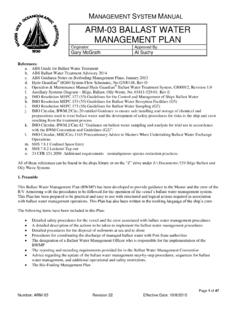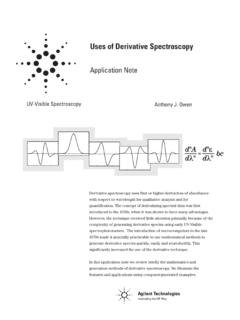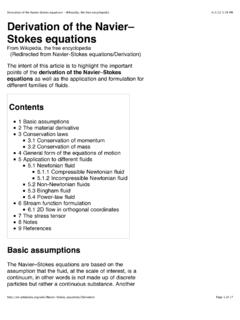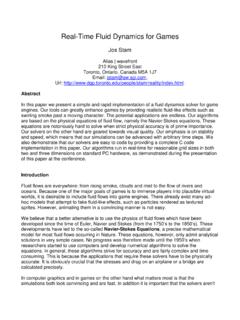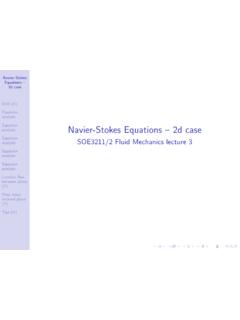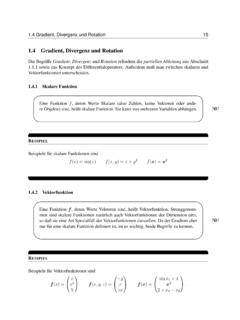Transcription of Chapter 3 The Stress Tensor for a Fluid and the Navier ...
1 Chapter 3 The Stress Tensor for a Fluid and the Navier Stokes Equations Putting the Stress Tensor in diagonal form A key step in formulating the equations of motion for a Fluid requires specifying the Stress Tensor in terms of the properties of the flow, in particular the velocity field, so that the theory becomes closed , that is, that the number of variables is reduced to the number of governing equations. We are going to take up this issue with some care because the same issue arises often, even now, when it is necessary to represent the action of small scale motions and their momentum fluxes in terms of large scale motions.
2 In the formulation we have to be clear about what symmetries of the system need to be respected (for example, the symmetry of the Stress Tensor itself). So the approach we take here has application beyond the formulation of the basic equations. In the example of the last Chapter we saw that a Stress Tensor that had only a diagonal component in one coordinate frame would have, in general, off diagonal components in another frame. More generally, since the Stress Tensor is symmetric , we can always find a coordinate frame in which the stresses are purely normal , in which the entries in the Stress Tensor lie along the diagonal.
3 Consider the Stress Tensor !ijwhich is generally not diagonal and let us find the transformation matrix aij which renders it diagonal in a new frame. !'ij=aikajl!kl=!(j)"ij=!1000!2000!3#$%%% &'((( ( ) Chapter 3 2 The (j) in the parenthesis indicates that the index is not summed over. To find the transformation matrix that satisfies ( ) we multiply both sides of the equation by aim and carry out the indicated summation aimaik!mk!ajl"kl="(j)!ijaim="(j)ajm,#"ml ajl="(j)ajm ( a, b) For each j this is an equations for the three components of the vector ajm, m=1,2,3.)))
4 To be sure we understand the form of the problem, let s write out ( b) entirely. (!11"!(j))aj1+!12aj2+!13aj3=0,!21aj1+(!2 2"!(j))aj2+!23aj3=0,!31aj1+!32aj2+(!33"! (j))aj3=0. ( a, b, c) and recall that !12=!21, etc. This yields a simple eigenvalue problem for the !(j). There will be three eigenvalues corresponding to the three diagonal elements of the new Stress Tensor . For each eigenvalue there will be an eigenvector ajm,m=1,2,3. Since the Stress Tensor is symmetric the eigenvectors corresponding to different eigenvalues are orthogonal.
5 Thus, for !(j)"!(i), aimajm=!ij ( ) and the proof is an elementary one from matrix theory. Chapter 3 3 !mlajl=!(j)ajm,!mlail=!(i)aim,"!mlajlaim =!(j)ajmaim,!mlailajm=!(i)aimajm, ( a, b, c, d) Subtracting the two final equations yields !mlajlaim"!mlailajm=!(j)"!(i)()ajmaim, ( ) In the second term on the right hand side we interchange the dummy summation indices, letting m!l to obtain !mlajlaim"!lmaimajl=!(j)"!(i)()ajmaim, ( ) but since the Stress Tensor is symmetric, !ml=!lm and the left hand side of ( ) is zero and ( ) follows directly.
6 So we can always find a frame in which the Stress Tensor is diagonal, !ij=!1000!2000!3"#$$$%&''' ( ) The static pressure (hydrostatic pressure) Our definition of a Fluid is that if it is subject to forces, or stresses that will not lead to a change of volume it must deform and so not remain at rest. It follows that in a Fluid at rest the Stress Tensor must have only diagonal terms. Furthermore, the Stress Tensor would have to be diagonal in any coordinate frame because, clearly, the Fluid doesn t know which frame we choose to use to describe the Stress Tensor .
7 As we saw in the last Chapter the only second order Stress Tensor that is diagonal in all frames is one in which Chapter 3 4 each diagonal element is the same. We define that value as the static pressure and in that case the Stress Tensor is just, !ij="p#ij ( ) This also follows from the easily proven fact that ij is the only isotropic second order Tensor , that is , the only Tensor whose elements are the same in all coordinate frames. Sometimes p is called the hydrostatic pressure but that misleadingly suggests that it has something to do with a gravitational force balance.
8 Rather it is merely the pressure in a Fluid at rest and the fact that the Stress Tensor is isotropic implies that the normal Stress in any orientation is always p and the tangential Stress is always zero. This fact is often called Pascal s Law. Blaise Pascal (1623-1662) formulated his ideas in a discussion of the hydraulic force multiplier involving pistons of various diameters linked together hydraulically. The isotropy of the pressure was not a result that was accepted immediately by his contemporaries. For a Fluid at rest the pressure is also the thermodynamic pressure, that is, a state variable determined, say , by the temperature and the density.
9 When the Fluid is moving the pressure, defined as the average normal force on a Fluid element, need not be the thermodynamic pressure and we will have to consider that in more detail below. The average normal Stress is !jj/3=13(!11+!22+!33) ( ) this is (mistakenly ) taken to be p in several otherwise fine texts but it is strictly true only for simple mono atomic gases. In general there is a discrepancy between the average normal Stress and the pressure. It is true however, and is left as an exercise for the student, that the trace of the Stress Tensor !
10 Jj is invariant, the same in all coordinate systems. We can always split the Stress Tensor into two parts and write it !ij="p#ij+$ij ( ) Rouse, H. and S. Ince. 1957 History of Hydraulics. Dover Publications , New York pp269 Chapter 3 5 where !ijis called the deviatoric Stress . It is simply defined as the difference between the pressure and the total Stress Tensor and our next task is to relate it to the Fluid motion. Note that if we define the pressure as the average normal Stress then the trace of the deviatoric Stress Tensor , !
